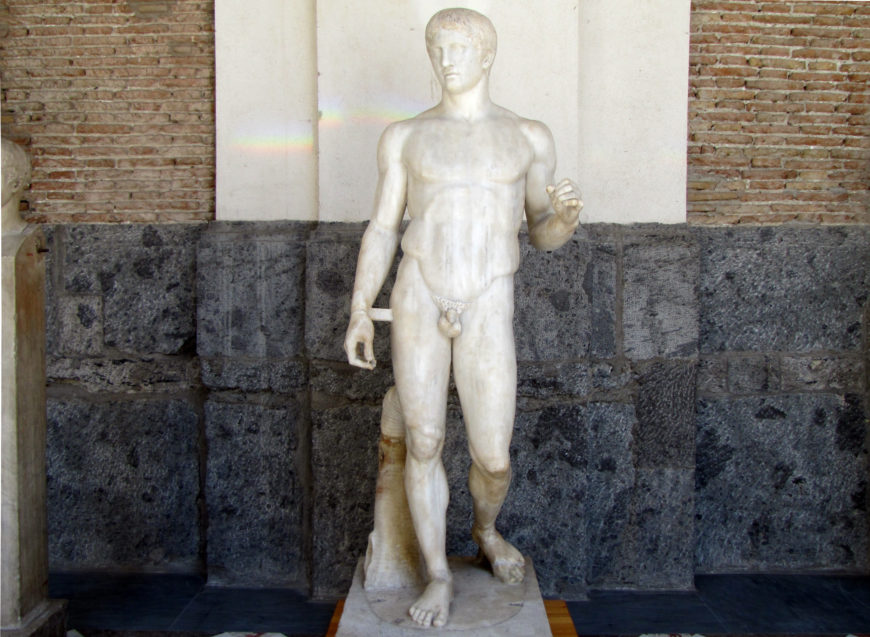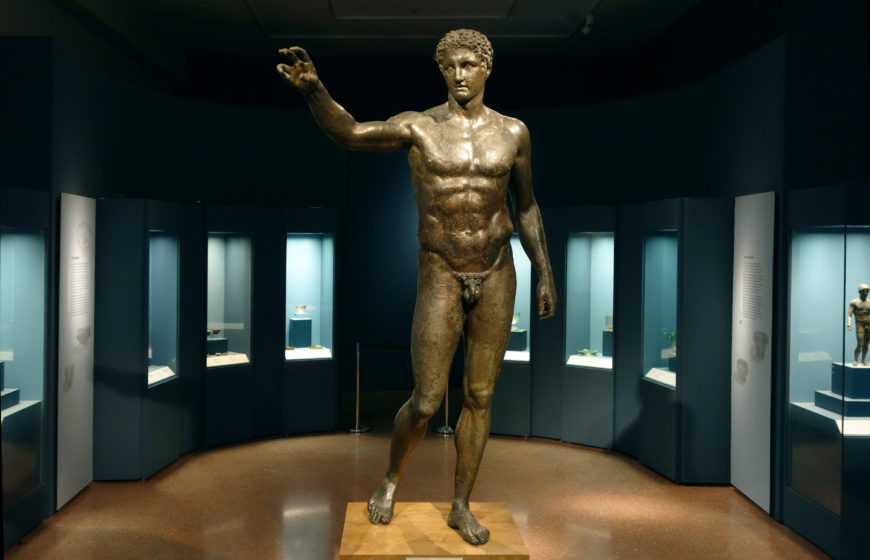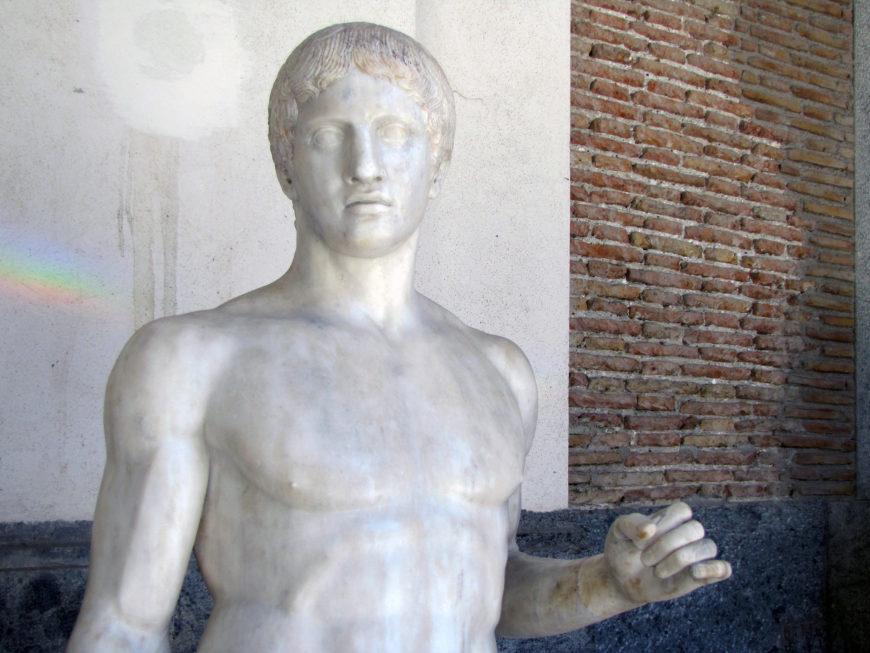For the ancient Greeks, the human body was perfect. Explore this example of the mathematical source of ideal beauty.
Polykleitos, Doryphoros (Spear-Bearer), Roman marble copy after a Greek bronze original from c. 450–440 B.C.E. (Museo Archaeologico Nazionale, Naples). Speakers: Dr. Steven Zucker and Dr. Beth Harris
Roman copies of ancient Greek art
When we study ancient Greek art, so often we are really looking at ancient Roman art, or at least their copies of ancient Greek sculpture (or paintings and architecture for that matter).
Basically, just about every Roman wanted ancient Greek art. For the Romans, Greek culture symbolized a desirable way of life—of leisure, the arts, luxury and learning.

Polykleitos, Doryphoros (Spear-Bearer) or Canon, Roman marble copy of a Greek bronze, c. 450–440 B.C.E. (Museo Archaeologico Nazionale, Naples; photo: Steven Zucker, CC BY-NC-SA 2.0)
The popularity of ancient Greek art for the Romans
Greek art became the rage when Roman generals began conquering Greek cities (beginning in 211 B.C.E.), and returned triumphantly to Rome not with the usual booty of gold and silver coins, but with works of art. This work so impressed the Roman elite that studios were set up to meet the growing demand for copies destined for the villas of wealthy Romans. The Doryphoros was one of the most sought after, and most copied, Greek sculptures.

Example of original Greek bronze sculpture, Antikythera Youth, 340–330 B.C.E., bronze, 1.96 m high (National Archaeological Museum, Athens, photo: Steven Zucker, CC BY-NC-SA 2.0)
Bronze versus marble
For the most part, the Greeks created their free-standing sculpture in bronze, but because bronze is valuable and can be melted down and reused, sculpture was often recast into weapons. This is why so few ancient Greek bronze originals survive, and why we often have to look at ancient Roman copies in marble (of varying quality) to try to understand what the Greeks achieved.

Detail showing hand where bronze spear was once held, Polykleitos, Doryphoros (Spear-Bearer) or Canon, Roman marble copy of a Greek bronze, c. 450–440 BCE (Museo Archaeologico Nazionale, Naples; photo: Steven Zucker, CC BY-NC-SA 2.0)
Why sculptures are often incomplete or reconstructed
To make matter worse, Roman marble sculptures were buried for centuries, and very often we recover only fragments of a sculpture that have to be reassembled. This is the reason you will often see that sculptures in museums include an arm or hand that are modern recreations, or that ancient sculptures are simply displayed incomplete.
The Doryphoros (Spear-Bearer) in the Naples museum (image above) is a Roman copy of a lost Greek original that we think was found, largely intact, in the provincial Roman city of Pompeii. [1]
The canon
The idea of a canon, a rule for a standard of beauty developed for artists to follow, was not new to the ancient Greeks. The ancient Egyptians also developed a canon. Centuries later, during the Renaissance, Leonardo da Vinci investigated the ideal proportions of the human body with his Vitruvian Man .
Polykleitos’s idea of relating beauty to ratio was later summarized by Galen, writing in the second century,
Beauty consists in the proportions, not of the elements, but of the parts, that is to say, of finger to finger, and of all fingers to the palm and the wrist, and of these to the forearm, and of the forearm to the upper arm, and of all the other parts to each other. Galen, De Placitis Hippocratis et Platonis
Notes:
[1] Recent scholarship suggests that the Doryphoros sculpture in the Naples museum may not have been found in a Palestra at Pompeii. See Warren G. Moon, editor, Polykleitos, The Doryphoros and Tradition (Madison: University of Wisconsin Press, 1995).
[0:00] [music]
Dr. Steven Zucker: [0:04] So much ancient Greek art and literature has been lost, and often we only have echoes of the original. That’s the case with one of the most famous works of art to come down to us from antiquity, Polykleitos’ “Canon,” which is known in the modern world as the “Doryphoros,” which means “Spear-bearer.”
Dr. Beth Harris: [0:25] Polykleitos wrote a book called “The Canon” in the 5th century B.C.E., where he defined what beauty was in sculpture, and he made a sculpture in bronze to go with this book to illustrate its precepts, but neither the book nor the sculpture survive. All we have are echoes, and we’re looking at one here today in the museum in Naples.
Dr. Zucker: [0:50] It’s a Roman copy in marble, and it’s one of dozens and dozens of copies of the original lost Doryphoros.
Dr. Harris: [0:58] This particular one was found in the palestra in Pompeii, that is, a place where athletes would work out. You can see why. We have a beautiful nude figure. It’s something for athletes to aspire to, something perfect. That was exactly Polykleitos’ idea.
Dr. Zucker: [1:16] We think that the original “Canon,” that is, the book that described Polykleitos’ ideas, thought about beauty as rooted in a kind of mathematical precision, in the relationship of one part of the body to another part of the body, one part of the body to all other parts of the body. It was the relationship in a balance, the harmony between these elements, that created beauty.
Dr. Harris: [1:39] This mathematical underpinning echoes the work of Pythagoras. One of the things that Pythagoras wrote about was how, in music, what makes harmony is the mathematical relationships between notes.
[1:54] Pythagoras theorized that that kind of mathematical thinking, that those ratios, if they created harmony in music, they might also be the key to understanding harmony and beauty in the human body.
Dr. Zucker: [2:07] So what we’re seeing, in essence, is an illustration of a set of philosophical and mathematical ideas that reveals to us so much about ancient Greece. It’s so tantalizing to look at this sculpture and believe that this is very close to what Polykleitos produced. The problem is, there are variations among all of the copies that have been made, and we don’t know which is closer to the original.
Dr. Harris: [2:32] But we do know that we’re looking at a male figure who is ideally beautiful, not only in his proportions but also in his musculature, the way that his ribs are articulated, his pectoral muscles, the muscles in his arms. There’s an attention to the human body and the potential for movement.
Dr. Zucker: [2:52] The original sculpture was made at a point in ancient Greek history that art historians often call the early Classical, when sculptures are moving out of this stiffer, more symmetrical, more abstracted representation of the human body and moving to a newfound naturalism, moving to a carefully observed body.
[3:13] We’re not seeing an individual here, this is not a portrait. This is an ideal representation, something that the Greeks were really interested in: what would the most perfect body look like?
[3:24] His weight has shifted onto his right leg and is moving off of his left leg. It is that transitional moment when he is about to lift that leg and perhaps move it forward as he begins to walk. This is a system of representation that we call contrapposto, which literally means the shifting of the axes of the body against each other.
[3:42] Contrapposto beautifully reflects the Greek interest in the human body in all of its complexity. Look at the way that the weight leg, the right leg’s, hip thrusts upward and compresses the torso on that side. In opposition to that, look at the way that the left hip hangs down, just above the leg with the bent knee.
Dr. Harris: [4:01] It’s more than just the harmony of the parts of the body. It’s also about this relationship between weight-bearing and not weight-bearing, of tension and relaxation.
[4:13] If we think of the Archaic figures, where the body is much more symmetrical, the weight is equally placed on both legs. Those figures have a sense, to me, of transcendence, of not quite being in the same world that I exist in. But this figure, which is asymmetrical, appears to exist in my world.
Dr. Zucker: [4:35] But it’s important to remember that we’re seeing a Roman marble copy of an older bronze sculpture from ancient Greece. And there are some changes that had to be made. Marble is heavy and it cracks much more easily, so it has to be supported in a way that bronze sculptures do not.
[4:52] And so we see a support that’s been added, a kind of tree trunk that’s necessary to help support the great weight of this stone. In addition, you can see that there’s a bridge that attaches the right wrist to the right hip, and this is to help stabilize the sculpture.
[5:06] In fact, you can see that despite that, the hand had been broken off. Then finally, the original bronze sculpture would have held a spear in his left hand that would likely have just rested against his left shoulder.
Dr. Harris: [5:19] I think a good question is, why are there so many Roman copies of this sculpture by Polykleitos? The answer to that is, the ancient Romans loved Greek art and collected it and copied it, and the wealthy elites of ancient Rome put sculptures like this in their gardens, in their villas, to display their erudition, their sense of being cultured.
Dr. Zucker: [5:47] And in this case, in a palestra, in a kind of gymnasium, to inspire Roman athletes to this Greek ideal.
[5:52] [music]

